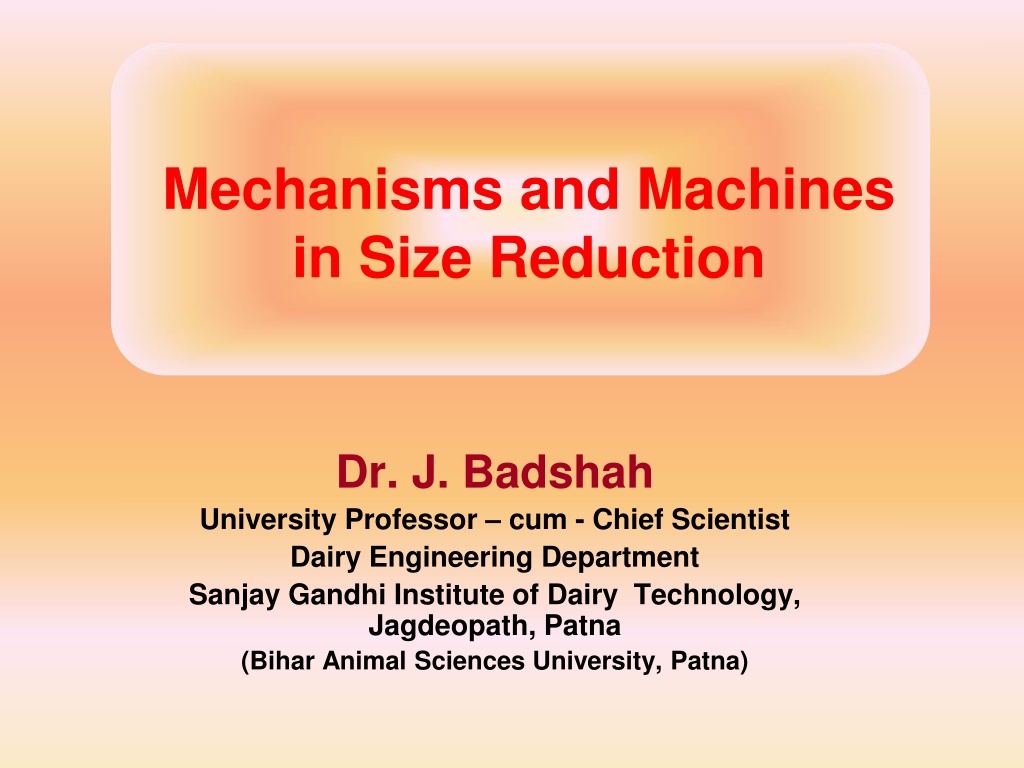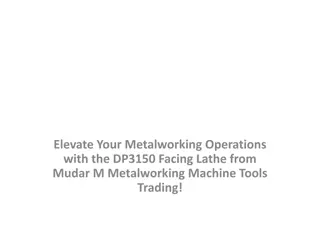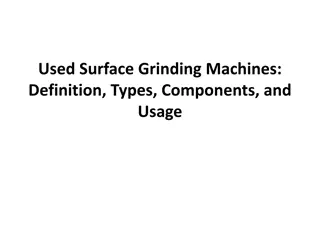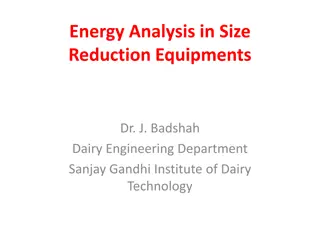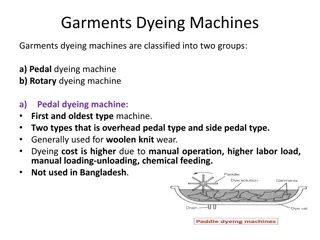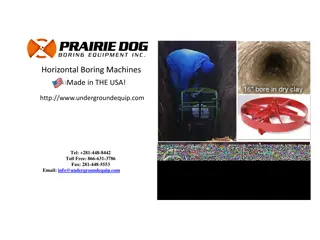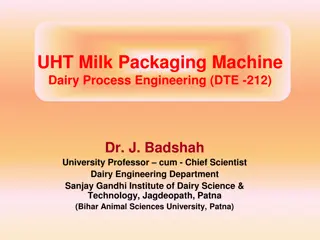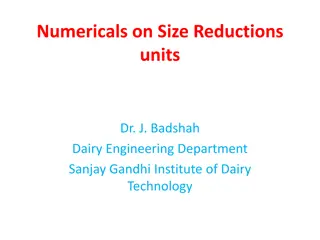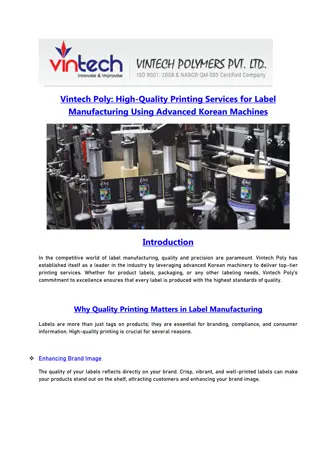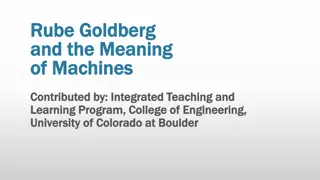Understanding Mechanisms and Machines in Size Reduction by Dr. J. Badshah
Explore different mechanisms and commercial machines used in size reduction processes, along with modes of operation like open circuit grinding and wet milling. Learn about the various applications and operating methods for efficient size reduction in industries.
Download Presentation

Please find below an Image/Link to download the presentation.
The content on the website is provided AS IS for your information and personal use only. It may not be sold, licensed, or shared on other websites without obtaining consent from the author. Download presentation by click this link. If you encounter any issues during the download, it is possible that the publisher has removed the file from their server.
E N D
Presentation Transcript
Mechanisms and Machines in Size Reduction Dr. J. Badshah University Professor cum - Chief Scientist Dairy Engineering Department Sanjay Gandhi Institute of Dairy Technology, Jagdeopath, Patna (Bihar Animal Sciences University, Patna)
Mechanisms in size reductions Different Mechanisms i. Pressure between two surfaces ii. Cutting between two surfaces iii. Shear stresses iv. Impact against solid surfaces v. Impact with another particles vi. Shearing in surrounding medium vii.Rubbing or Friction viii.Size reduction through non-mechanical means such as radiation, heat, electricity or explosion. ix. Combination of these mechanisms
Commercial Size Reduction Machines and Applications Pinned Disc Mill: Impact mechanism- Peripheral velocity 80- 160 m/s- Cocoa Kernels roasted nuts and sugar crystals breaking. Blast Mill: Impact mecahnisms- 40- 110 m/s similar applications Disc Beater mill: Impact and shear mechanisms- 70-90 m/s- Common cereal grains and milk powder grinding Hammer Cage wheel: Impact- 70-90 m/s - Ginger Roots and bark for drugs preparation Toothed Disc mill (Vertical): Rubbing and shearing- 4 -8 m/s Granulating Frozen coffee extract Toothed Disc Mill (Horizontal): Rubbing and shearing- 17 m/s- Degermination of corn, Fish meal production, spice extraction
Modes of operating of size reduction Plant Open Circuit Grinding: No restriction to come out the caught products by rolling and feeding Choke Feeding: When the feed rate exceeds the product rate, the condition is known as choke feeding. In choke feeding, particle breakage occurs between the plates and particles and themselves. Choke feeding produces fines; desirable for liberation purposes. Depending upon the requirement of size of product, the screen may be changed to avoid choking. Free Crushing: Two rollers rotating in opposite direction caught the materials to be crushed and allow to come out. between the particles
Modes of operating of size reduction Plant Wet milling: i. Wet-milling is a material is steeped in water, with or without sulfur dioxide, to soften the seed kernel in order to help separate the kernel s various components. ii. The feed material is carried through the action zone of the mill in a stream of water. For example, wet-milling plants can separate a 56-pound bushel of corn into more than 31 pounds of cornstarch (which in turn can be converted into corn syrups or corn ethanol), 15 pounds of corn gluten meal for use in animal feed, and nearly 2 pounds of corn oil. Wet milling of soybean is preferred. Close Circuit Feeding: Classifier is followed by mill where oversize particles are retained and undersize particles pass through screen. The oversize particles are again fed with original feed to mill. process in which feed
Factors Governing the size reduction process Moisture content of the feed: Grinding rate, efficiency and throughput of mill decreases with increase in moisture content of the feed. It also increases choking and sticking of materials. If the feed materials is too dry, it may not breakdown in an appropriate way and break into particles which may not be separated by the screens and may contaminate the white flour. Each type of grains will have an optimum moisture content for milling. Temperature Sensitivity of the feed: The generated heat can cause the temperature of the feed to rise significantly and a loss in quality could result. If softening or melting temperatures of the materials performance of the mill may be impaired. Some mills are equipped with cooling jackets to reduce the heating effects. Cryogenic milling i.e. mixing solid CO2 or liquid nitrogen with feed reduces undesirable materials like meat are exceeded, the heating effects for fibrous
Factors Governing the size reduction process & selection of mechanisms Mechanical Properties requirement increases with increase in mill speed, fineness modulus and also with hard materials having higher modulus of elasticity. The brittle materials fracture rapidly above the elastic limit. If the harder material is ductile, it will deform extensively before break down at ultimate yield point. It will require more energy to break. For very hard materials, the dwell time in action zone must be extended, which may mean a lower throughput or the use of a relatively large mill. The working surfaces should be made of hard wearing materials such as manganese steel for handling very hard abrasive materials. Power of materials:
Roller Mill Two cylindrical steel rolls mounted on horizontal axes and rotating towards each other. The feed is directed between the rollers from above. They are nipped and pulled through the rolls where they are subjected to compressive forces, which bring about their break down. If the rollers turn at different speeds, shear forces may be generated which will also contribute to the breakdown of the feed.
Ball Mill Both shearing and Impact forces are utilized in the size reduction, The unit consists of horizontal slow speed rotating cylinder containing a charge of steel balls or flint stones. As the cylinder rotates, the balls are lifted up the sides of the cylinder and drop on to the materials being comminuted. The balls also tumble over each other, exerting a shearing action on the feed materials. Balls sizes are usually in the range of 1- 6 inches. Small balls give more point of contacts but larger balls give greater impact.
Critical speed of the Ball Mill Shear force or attrition predominates at low speed but impact forces predominates at higher speed as the lifting up of the balls and falling causes impact stress at high speed. But at very high speeds, the balls are not fallen but carried along the sides of the wall with centrifugal forces. Therefore, critical speed of the roller is that speed at which the small sphere inside mill just begins to centrifuge and is given by: Nc= (1/2 ) g/ (R r), where, R is the radius of the roller and r is the radius of the balls. In practice, the optimum operating speed is about 75 % of the critical speed and should be determined under plant operating condition.
Pin Mill (Pin-disc mill) Both discs have concentric rows of pins, pegs or teeth. The rows of one disc fit alternately into the rows of the other disc. The feed is introduced through the centre of the stationary disc and passes radially outwards through the mill. It is subjected to impact and shear forces between the stationary and rotating pins. The mill may be operated in a choke feed mode by having a screen fitted over the whole or part of the periphery. The pins may be of different shapes such as round, square or in the form of blades.
Fluid Energy Jet Mill The solid particles to be comminuted are suspended in a gas stream travelling at high velocity into a grinding chamber. Break down occurs through individual particles and with the wall of the chamber. The gasses used are compressed air or superheated steam at a pressure of the order of 700 Kpa. A cyclone separator is used to recover the product. A feed of around 150 mm is converted to particles of around 10 mm. Energy efficiency of such mills is relatively low. the impact between
Rod Mill High carbon steel rods of diameter 25-125 mm extend to almost the full length of the shell and occupy about 35% of the shell volume. They are classed as intermediate grinders and are more useful for sticky materials. In rod mills, attrition / shear forces predminates but impact also play a part in size reductions.
